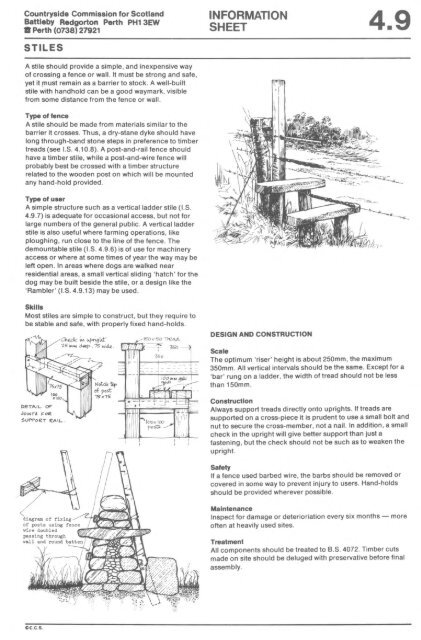information - Scottish Natural Heritage
information - Scottish Natural Heritage
information - Scottish Natural Heritage
You also want an ePaper? Increase the reach of your titles
YUMPU automatically turns print PDFs into web optimized ePapers that Google loves.
Countryside Commission for Scotland<br />
Battleby Redgorton Perth PH13EW<br />
a Perth (0738)27921<br />
STILES<br />
A stile should provide a simple, and inexpensive way<br />
of crossing a fence or wall. It must be strong and safe,<br />
yet it must remain as a barrier to stock. A well-built<br />
stile with handhold can be a good waymark, visible<br />
from some distance from the fence or wall.<br />
Type of fence<br />
A stile should be made from materials similar to the<br />
barrier it crosses. Thus, a dry-stane dyke should have<br />
long through-band stone steps in preference to timber<br />
treads (see I S. 4.10.8). A post-and-rail fence should<br />
have a timber stile, while a post-and-wire fence will<br />
probably best be crossed with a timber structure<br />
related to the wooden post on which will be mounted<br />
any hand-hold provided.<br />
Type of user<br />
A simple structure such as a vertical ladder stile (I.S.<br />
4.9.7) is adequate for occasional access, but not for<br />
large numbers of the general public. A vertical ladder<br />
stile is also useful where farming operations, like<br />
ploughing, run close to the line of the fence. The<br />
demountable stile (I S. 4.9.6) is of use for machinery<br />
access or where at some times of year the way may be<br />
left open. In areas where dogs are walked near<br />
residential areas, a small vertical sliding 'hatch' for the<br />
dog may be built beside the stile, or a design like the<br />
'Rambler' (I.S. 4.9.13) may be used.<br />
Skills<br />
Most stiles are simple to construct, but they require to<br />
be stable and safe, with properly fixed hand-holds.<br />
©c.c.s.<br />
INFORMATION<br />
SHEET<br />
DESIGN AND CONSTRUCTION<br />
4.9<br />
Scale<br />
The optimum 'riser' height is about 250mm, the maximum<br />
350mm. All vertical intervals should be the same. Except for a<br />
'bar' rung on a ladder, the width of tread should not be less<br />
than 150mm.<br />
Construction<br />
Always support treads directly onto uprights. If treads are<br />
supported on a cross-piece it is prudent to use a small bolt and<br />
nut to secure the cross-member, not a nail. In addition, a small<br />
check in the upright will give better support than just a<br />
fastening, but the check should not be such as to weaken the<br />
upright.<br />
Safety<br />
If a fence used barbed wire, the barbs should be removed or<br />
covered in some way to prevent injury to users. Hand-holds<br />
should be provided wherever possible.<br />
Maintenance<br />
Inspect for damage or deterioriation every six months — more<br />
often at heavily used sites.<br />
Treatment<br />
All components should be treated to B.S. 4072. Timber cuts<br />
made on site should be deluged with preservative before final<br />
assembly.

















